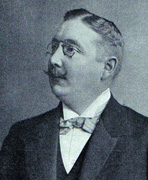Wilhelm Aletter
Wilhelm Aletter (born January 27, 1867 in Nauheim , † June 30, 1934 in Wiesbaden ) was a German pianist , violinist , composer , publisher and inventor . As a composer he also used the pseudonyms Alphonse Tellier , Leo Norden , Sam Weller and Herbert Wells Thayer .
Life
He grew up in Bad Nauheim. As early as 1892 he published a collection of 12 piano pieces. In Berlin he studied piano, violin and composition with Theobald Rehbaum and Engelbert Humperdinck from 1894 to 1896 and worked as a pianist, composer and music dealer. He wrote salon music for orchestra and piano as well as numerous couplets and songs .
His musical work comprises a total of over 342 opus numbers and his published sheet music editions have been distributed worldwide - also under license from other music publishers. The most successful was his play "Rendez-vous" , which was published and sold between 1894 and 1960 in 58 editions and six languages. Another great success was the hit song “I am a widow (song and Rhinelander)” with an early text by Otto Reutter, published in 1898 by the American music publisher The BFWood Music Company Boston . From 1905 he made recordings of his songs with Margarete Wiedeke ( mother, the man ; Wilhelm, you are a plant ), Harry Steier (oh, could I love one more time) , the Victor Concert Orchestra and others. Later founded his own publishing house in Berlin-Steglitz .
During the First World War , Aletter was also active as an inventor and in 1916, after the first food rationing, brought the "Heinzelmännchen" cooking, roasting and baking apparatus and the "OBU" griddle onto the market, in which one could roast without fat. In addition, he published a cookbook written by the well-known women's rights activist Hedwig Heyl , in the foreword of which he promised to send one of his compositions free of charge with a personal dedication to every person who sent another recipe. It was “only to be stated whether the pieces should be kept in a light or serious style. Likewise, with songs, the pitch of the voice, with piano pieces the degree of difficulty. It's all there. " . Karl Kraus wrote the anti-war satire for the magazine Die Fackel in 1917 : “It's all there” .
Works (selection)
Orchestra, salon orchestra
|
piano
Chamber music
Songs
|
Recordings
- I am a widow (www.rcaguilar.com) ( MID ; 25 kB)
- Rendez-vous (Victor Concert Orchestra 1913)
- Tristesse d'amour (Salon Orchestra Erfurt 2011)
Sources and literature
- Wolfgang Adler: Schlagerchronik 2nd edition SFB Volume 3, Berlin 1987
- Paul Frank / Wilhelm Altmann : Kurzgefasstes Tonkünstler-Lexikon, 12.A., Leipzig 1926
- Hedwig Heyl : Roasting booklet for roast and pan dishes to roast on the whole. cut grate pan »OBU« , Verlag W. Aletter, Berlin-Steglitz, January 1917
- Karl Kraus : It's all there in: Die Fackel, No. 445–453, XVIII. Year, Vienna, January 18, 1917.
Web links
- Victor discography
- Sheet music and audio files by Wilhelm Aletter in the International Music Score Library Project (The works are in the public domain .)
Individual evidence
- ↑ "It's all there" at textlog.de
| personal data | |
|---|---|
| SURNAME | Aletter, Wilhelm |
| ALTERNATIVE NAMES | Tellier, Alphonse (pseudonym); Norden, Leo (pseudonym); Weller, Sam (pseudonym); Wells Thayer, Herbert (pseudonym) |
| BRIEF DESCRIPTION | German pianist and composer |
| DATE OF BIRTH | January 27, 1867 |
| PLACE OF BIRTH | Bad Nauheim |
| DATE OF DEATH | June 30, 1934 |
| Place of death | Wiesbaden |

